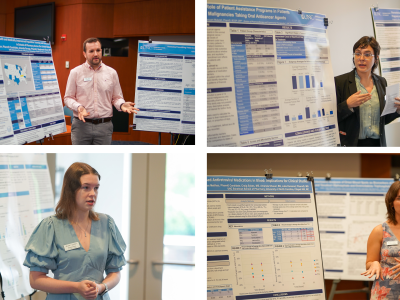February 7, 2006
Scientists at the UNC School of Pharmacy and Rensselaer Polytechnic Institute have discovered an alternative way to produce heparin, a drug commonly used to stop or prevent blood from forming dangerous clots.
Heparin is most often used during and after such procedures as kidney dialysis, heart-bypass surgery, stent implantation, indwelling catheters, and knee and hip replacement to prevent clots from forming and blocking or restricting the flow of blood. The annual worldwide sales of heparin are estimated at $3 billion.
“Synthesizing heparin chemically is extremely difficult, but by doing so, we eliminate the risk of viruses and other forms of contamination and improve the safety of a widely used drug,” says Jian Liu, PhD. “It gives us a cleaner compound. Our process mimics the existing process of extracting heparin from animal organs, so the synthetic version has very similar anticoagulant effect and can be metabolized in the body to maintain low drug toxicity.”
Heparin is a naturally occurring substance that is currently extracted from animal organs, which can make it difficult to produce consistently, Liu says. The new process could enable the current supply of the drug to be replaced or supplemented by the synthetic version. The new process can also be applied as a tool for discovering new drugs to fight cancer and viral diseases, according to the researchers.
UNC-Chapel Hill and Rensselaer researchers successfully synthesized hundreds of milligrams of heparin by developing a large-scale process involving engineered enzymes and cofactor recycling. The new, scaleable process can be applied to synthesize other heparin-based structures that regulate cell growth and may have applications in wound healing or cancer treatment, according to the researchers. The findings were reported December 30, 2005, in the Journal of Biological Chemistry in a paper titled “Enzymatic Redesigning of Biologically Active Heparan Sulfate.”
Researchers at MIT first developed a process to produce synthetic heparin but in amounts of less than one microgram, which is not enough to treat humans. One human dose of heparin is approximately 100 milligrams. Researchers are currently seeking a partner to support large-scale production of synthetic heparin for clinical studies, Liu says.
The process can also be applied in solid phase synthesis as a tool for screening lead compounds with heparin-like structures for drug discovery, according to the researchers. The findings were published January 13, 2006, in Biochemical and Biophysical Research Communication in a paper titled “Enzymatic Synthesis of Heparin-Related Polysaccharides on Sensor Chips: Rapid Screening of Heparin-Protein Interactions.”
Research in Liu’s group in the Division of Medicinal Chemistry and Natural Products of the School of Pharmacy focuses on the study of sulfated carbohydrates like heparin. Using recombinant biosynthetic enzymes, researchers design the structure of heparin to improve the anticoagulant activity as well as explore the antiviral and anticancer activities.
Liu collaborated on the interdisciplinary project with Robert Linhardt, the Ann and John H. Broadbent, Jr. ’59 Senior Constellation Professor of Biocatalysis and Metabolic Engineering at Rensselaer. Graduate and postdoctoral students involved in the work include Jinghua Chen (UNC-Chapel Hill), Eva Munoz (Rensselaer), Fikri Avci (Rensselaer), Ding Xu (UNC-Chapel Hill), Melissa Kemp (Rensselaer), and Miao Chen (UNC-Chapel Hill). The work was supported by the National Institutes of Health (NIH) and the American Heart Association. UNC-Chapel Hill and Rensselaer have jointly filed a provisional patent on the process.
Latest News

Dean Angela Kashuba receives Carolina Alumni Faculty Service Award

RASP poster presentations capture student research


